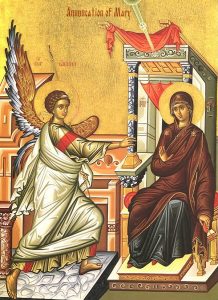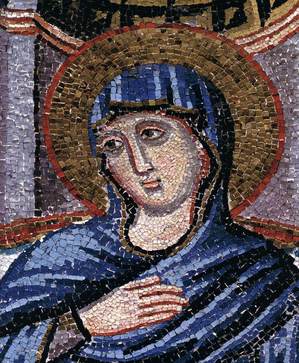Tag: Annunciation
Annunciation, a simple fact
Then Mary said, “Here am I, the servant of the Lord; let it be with me according to your word.” Then the angel departed from her. (Luke 1.38)
The feast of the Annunciation is important not simply as a historical commemoration of something that happened long ago, but more of what it reveals about God: that God chose to create a world in which, to realize the dream he had for creation, human freedom had to be included. God never “decrees” in a way that violates human freedom. Rather, God offers and looks for the free acceptance of the creature. Thus God did not simply plant Jesus on earth arbitrarily. God required the free assent of the creature. This is what Mary’s “Fiat” really is: an utterance that frees the Divine Will to realize the ultimate plan for all creation.
(Credit: NS)
Annunciation of Mary
Annunciation Mass March 25
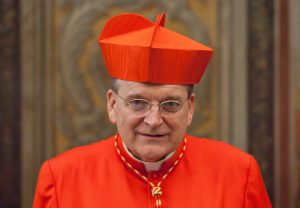
Solemnity of the Annunciation: Cardinal Burke to offer Mass March 25th
St. Mary Church, Greenwich, CT, 11:00 a.m., Solemn Pontifical Mass at the Throne, His Emminence Raymond Cardinal Burke, celebrant.
The day that changed human history
Nine Month Novena in Honor of the Virgin of the Incarnation
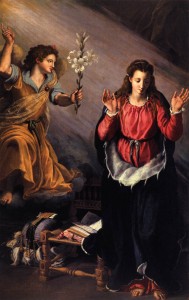 A friend of mine sent me an invitation to join her and others in praying this novena. It was given to her by a mutual friend a decade ago. Julie reports “each year, I am overwhelmed by the reports of the novenas prayed and the amazing prayers answered. Please seriously consider praying this quick prayer with me for the next nine months. I promise you: it will revolutionize your relationship with Our Lady, and your prayers will be heard and answered.”
A friend of mine sent me an invitation to join her and others in praying this novena. It was given to her by a mutual friend a decade ago. Julie reports “each year, I am overwhelmed by the reports of the novenas prayed and the amazing prayers answered. Please seriously consider praying this quick prayer with me for the next nine months. I promise you: it will revolutionize your relationship with Our Lady, and your prayers will be heard and answered.”
Julie has confidence in the regular prayers of the novena when she says:
If you do take it on, I further promise you: you will likely fail. You’ll forget a day; you might forget several days. Do what you must to remind yourself—stick the prayer to your bathroom mirror, and pray it while you’re brushing your teeth! Place it by your bed, inside or on top of something that you will look at every night. If (WHEN) you fail, then simply double up, or say it five extra times, if it makes you feel better. Whatever! Just do NOT give up. Run to your Mother, confide in her, and be certain that she won’t disown you when you fall down. God bless you and thank you for praying with me!
I am doing the same here: please join me in this sacrifice of prayer.
Nine Month Novena in Honor of the Virgin of the Incarnation
Prayed each day from the Solemnity of the Annunciation the Solemnity of the Nativity, March 25 – December 25. In this novena offer to Our Lady three intentions.
- Salve Regina (the Hail, Holy Queen…)
O Virgin of the Incarnation, a thousand times we praise thee, a thousand times we greet thee, for the joy thou didst know when the Son of God became flesh in thy womb. Because thou art most powerful, O Virgin Mother of God, grant what we beseech thee for the love of God: (here name the three intentions).
- Memorare (Remember, O most gracious Virgin Mary…)
- Hail Mary
May the heart of Jesus in the Most Blessed Sacrament, be praised, adored and loved with grateful affection at every moment in all the tabernacles of the world and in the hearts of all men, even until the end of time. Amen.
Earliest icon of the Annunciation
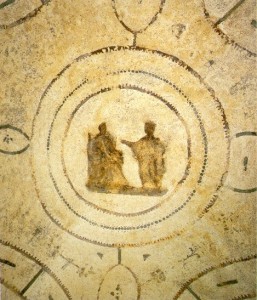 I love early Christian history. Don’t you? In fact, I have enjoyed time spent in the various musea, locally and notably here in New Haven, Connecticut at the Yale Art Museum where there is a marvelous exposition of Dura Europus, one of the earliest house churches. But there are marvelous early collections at the world’s musea. I’d suggest going on a study tour. The study of our early Christian roots is about our common Christian memory.
I love early Christian history. Don’t you? In fact, I have enjoyed time spent in the various musea, locally and notably here in New Haven, Connecticut at the Yale Art Museum where there is a marvelous exposition of Dura Europus, one of the earliest house churches. But there are marvelous early collections at the world’s musea. I’d suggest going on a study tour. The study of our early Christian roots is about our common Christian memory.
I saw this icon today in cyberspace making the historic claim of being the oldest surviving icon of the Annunciation. A terrific find! The icon is located in the Catacomb of Priscilla on theVia Salaria in Rome. This icon dates from the second century AD.
Several years ago I had the privilege of walking and praying in one of the catacombs but not this one. Historians of Christian archeology say that the Roman catacombs are treasuries of early iconography.
For more info on this early icon of the Annunciation is located here.
One of the interesting comments made is “One difference between this depiction of the Annunciation and later icons is that the Mother of God is shown with her head uncovered. In Rome, young virginal maidens would always have their heads uncovered, and so the imagery is in keeping with the Christian beliefs regarding Mary, the Mother of Jesus Christ. The veil worn in the East would come to dominate iconography of the Mother of God in later centuries.”
Annunciation to Mary
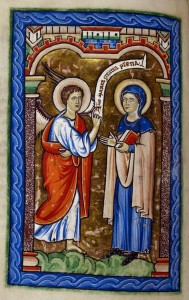 Today is the beginning of our salvation. Indeed, we rejoice in Mary’s “yes” to being the Mother of the Redeemer, and respond with our own “yes” today to God’s will in our lives.
Today is the beginning of our salvation. Indeed, we rejoice in Mary’s “yes” to being the Mother of the Redeemer, and respond with our own “yes” today to God’s will in our lives.
In the Servant of God Father Luigi Giussani’s Meditations on the Holy Rosary, he writes about the Annunciation:
The Angel’s words could have astounded with wonder and humility the young woman to whom they were addressed. But they were not so astounding as to be totally unintelligible; they contained something that made them intelligible to the heart of that young girl who was living her religious duties. The Virgin embraced them to herself: “I am the handmaiden of the Lord. Let it be done to me according to Your word.” Not because she understood but, in the confusion that had become boundless because of the Mystery that announced itself by vibrating in her flesh, the Virgin opened her arms wide, the arms of her freedom, and said, “Yes.” And she stayed alert every day, every hour, every minute of her life. The Virgin Mary’s state of mind, that state of mind which determines an attitude and decides for it in the face of the occasion and the moment, how can we better describe the Virgin’s state of mind than with the word “silence”? Silence as memory filled to overflowing. Two things contributed to this memory, two things determined this silence. The first was remembering what had happened. What had happened preserved its marvelousness, its true mystery, its mystery of truth intact because — and this is the second thing — it had something that was present: that Child, that present young Man, that Son who was present.
Going to the Church Fathers is always a good thing: Saint Ireneus of Lyons teaches us that “For as Eve was seduced by an angel’s voice to turn from God betraying His word, so Mary was given the good news by an angel’s voice that she would bear God, and the latter was persuaded to obey God, so that Mary should become the advocate of Eve. And as the human race was bound to death by a virgin, by a virgin it was delivered.”
The Annunciation: God’s presence among us is true
Lent and Easter interrupted the March 25th observance of the Annunciation, so the Church transferred the Solemnity of the Annunciation until today. Two striking pieces for our mediation: one from Saint Leo the Great and the other from the Servant of God Father Luigi Giussani.
Each one is a partaker of this spiritual origin in regeneration. To every one, when he is reborn, the water of baptism is like the Virgin’s womb, for the same Holy Spirit fills the font, who filled the Virgin, that the sin, which that sacred conception overthrew, may be taken away by this mystical washing. [s. 24.3]
St. Leo the Great
AND
The Angel’s words could have astounded with wonder and humility the young woman to whom they were addressed. But they were not so astounding as to be totally unintelligible; they contained something that made them intelligible to the heart of that young girl who was living her religious duties. The Virgin embraced them to herself: “I am the handmaiden of the Lord. Let it be done to me according to Your word.” Not because she understood but, in the confusion that had become boundless because of the Mystery that announced itself by vibrating in her flesh, the Virgin opened her arms wide, the arms of her freedom, and said, “Yes.” And she stayed alert every day, every hour, every minute of her life. The Virgin Mary’s state of mind, that state of mind which determines an attitude and decides for it in the face of the occasion and the moment, how can we better describe the Virgin’s state of mind than with the word “silence”? Silence as memory filled to overflowing. Two things contributed to this memory, two things determined this silence. The first was remembering what had happened. What had happened preserved its marvelousness, its true mystery, its mystery of truth intact because — and this is the second thing — it had something that was present: that Child, that present young Man, that Son who was present.
Luigi Giussani
Meditations on Rosary
The Annunciation: the beginning of salvation
Today is the beginning of our salvation,
The revelation of the eternal mystery!
The Son of God becomes the Son of the Virgin.
As Gabriel announces the coming of Grace.
Together with him let us cry to the Theotokos:
Rejoice, O Full of Grace,
The Lord is with You!
(Troparion, Tone 4)
Indeed, today is the beginning of salvation history. As St Luke’s gospel (1:26-38) reveals, and as other languages portray the Incarnation, we’ve received “good tidings.” From the moment the angel’s message was received positively by Mary cosmic history has never been the same. March 25 is the solemnity of the Annunciation to the Mary that she’s be the Mother of God (the most Holy Theotokos). And it’s Holy Week followed by Eastertide, the Church will observe this solemn occasion on April 8. Nevertheless, a word or two need to be said about the Annunciation.
Liturgical history tells us that there exists a 2nd century painting of the Annunciation in the catacomb of Priscilla. And more widely celebrated since the 4th century, the Christian community has observed the Annunciation as a solemn day of grace.
Ecclesiastical history bears witness to the Council of Toledo in 656 mentioning the Feast in Spain and then at the Council in Trullo in 692 indicating the Church there having a celebration of the Annunciation even though it was Lent. The Fathers of the Second Vatican Council spoke about the Marian principle of the Church as being fundamental to the life of the Church (see the conclusion of Lumen Gentium), even more important that the Petrine principles because what we believe to be true about the Incarnation.
On the Annunciation, the Knights of Columbus pray for the unborn children and the work of being pro Life.
The feast testifies that God fulfills His promise to send a Redeemer (Genesis 3:15): “I will put enmity between you and the woman, between your seed and her seed; he shall crush your head, and you shall lie in wait for his heel.” What the prophets and teachers of the Law believed and taught the people of Israel, was given by Gabriel’s announcement; and in the Christian dispensation the Fathers of the Church have taught that what is called “her seed” to refer to Jesus. Here is an unmistakable theological view that Jesus is the new Adam, the new tree of life, the new Law, the new Lawgiver, the new face of God.
Continue reading The Annunciation: the beginning of salvation
